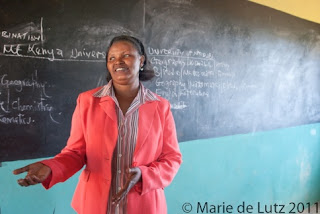
GIVEWATTS! Goes to Machakos

A few weeks ago, when I was still living in Nairobi (yes, I have since moved to the good ol' U.S. of A.), I went with this great organisation called GIVEWATTS to a town called Kathiani, a few kilometres from Machakos. Above: a bus transporting people through Kathiani. Right: stores in Kathiani.
Machakos is about an hour and a half from Nairobi, off the road going towards Mombasa (which has been wonderfully rehabilitated since the last time I took it!). Left: houses on the road from Machakos town to Kathiani.

GIVEWATTS helps schools and clinics by installing renewable energy such as solar panels. Towards the end of January, Jesper Hornberg (pictured right), who works with GIVEWATTS, invited me to come with him on a trip to Kathiani, where we visited a clinic and two schools that currently don't have access to electricity on the premises.

Janet (pictured with her neice, left) had talked to Jesper about Kathiani, her town, and about a Clinic, primary school, and a highschool that don't currently have access to electricity.

So we went to check it out.
And it was beautiful!
We first stopped by a local clinic providing services to the community, particularly mothers and children.


They have a room specifically set up to care for newborns and young children, providing babies with vaccinations in their first year of life.

And are in the process of setting up a maternity ward, given that the hospital is rather far away and a pregnant mother doesn't always have the time or resources to get there. Right: the building for the future maternity ward.
The clinic has a water tank, but doesn't yet have access to running water.
There is no electricity either, but the grid isn't far away: with an albeit strong investment, they'll be able to pull the electrical cables from the road to the clinic.
We then took the road again,
Went to the Kauti Primary School,

And visited some pretty awesome kids.
We met Deputy Head Teacher Mrs. Mwema, (pictured right) who told us of how Kauti was built and has found its financial backing from parents. In fact, Janet and her siblings all went to Kauti, as have their children!
So Kauti is more than a school, it's a solid part of the community. Left: classrooms.
And it has classes from pre-school all the way to Standard 8, which is the equivalent of 8th grade in the U.S. or 4ème in France. Right: the Standard 8 class.
Kauti primary school is a bit like the clinic we had just visited in the sense that the electrical grid is not so far from the school. This means it wouldn't make sense to install solar panels, because the school can get on the KPLC (Kenya Power and Lighting Company) grid. Left: pre-schoolers.
However, there are a host of other products that could be useful for them, including solar lanterns that students can bring home so they have light when they do homework. Right: Standard 4 students watching the commotion from their classroom window.
These replace harmful oil lanterns, which are bad for people's health, the environment and provide a very dull light which isn't so great for the eyes of a hardworking pupil. Left: students coming to talk to us at the school fence.
After our visit to Kauti Primary School, we went to Kauti Highschool, which is just down the street.


Kauti Secondary is new, it has only been running for two years. Pictured above: Form 3 students.
The school has three classes: Forms 1-3 (the first three years of high school).
Like the Clinic and Kauti Primary, Kauti Highschool is located only a few metres from an electrical pole, which means that the best thing to do may be to connect them to the electrical grid. Having electricity in the school would allow students to stay later in the evening and study.
After visiting Kauti Highschool, we went to Janet's house for lunch, and passed a few farms on the way. Pictured left: maize, right: coffee.


In the afternoon, we left Kathiani to visit Janet's daughter, who's in boarding school. But on the way we had one last stop to make at the International Holiness Pentecostal Church of Kathiani, which Pastor Ngulu, who had been one of our hosts throughout the day, had invited us to visit.
Pastor Ngulu's church is still under construction, and also doesn't have electricity. The congregation has come together to complete construction of the church, and each person has a dedicated piece of wall which they must finish plastering by this month (pictured right).

While GIVEWATTS as an organisation does not cover religious institutions, we greatly enjoyed the opportunity to visit the church,
the schools and clinic,
the beautiful landscape,
and a great reason to get out of the city for a day!
Check out GIVEWATTS at www.givewatts.org to see how you can help
their blog about Machakos at
and Jesper's personal blog about energy at www.energymindfulness.



















No comments:
Post a Comment